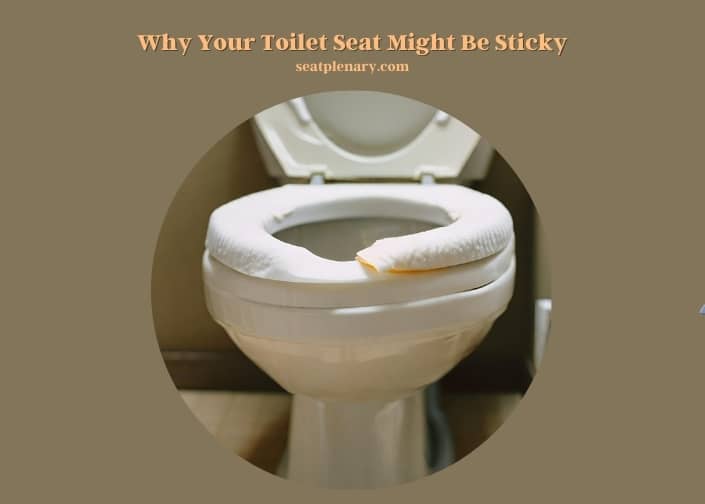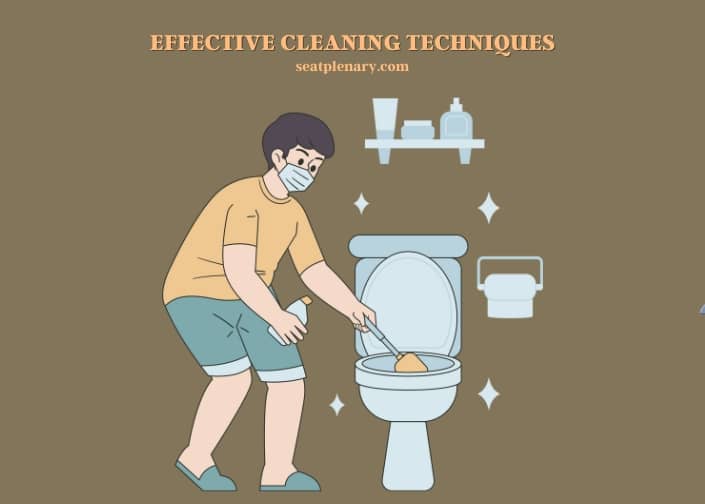A sticky toilet seat can be both unpleasant and puzzling. The reasons behind this issue are varied and often easily solvable.
Toilet seats can become sticky due to a buildup of various substances. Regular use and insufficient cleaning are primary factors. Over time, urine, fecal particles, and toilet cleaning agents can accumulate on the seat’s surface. This residue, if not cleaned properly, can lead to a sticky sensation. In households with young children, accidental spills of products like baby oil or lotions can also contribute to the stickiness.
Environmental factors play a role too. High humidity in bathrooms can cause moisture to settle on the toilet seat, making it feel sticky. This is especially true in areas without proper ventilation. In some cases, the material of the toilet seat itself can react to the humidity or chemicals used for cleaning, leading to a degradation of the surface and a resultant sticky feel.

Regular cleaning with appropriate cleaning agents is essential in preventing this issue. It’s recommended to use a mild detergent or a mixture of vinegar and water for effective cleaning. Avoid harsh chemicals that can damage the seat’s surface. Ensuring good ventilation in the bathroom can also help in reducing humidity-related stickiness.
For more detailed insights and solutions on maintaining a clean and non-sticky toilet seat, feel free to read the detailed article below.
Why Your Toilet Seat Might Be Sticky?
Stickiness of Toilet Seats
Have you ever wondered why your toilet seat feels sticky, even after a good scrub? It’s not just about cleanliness; several factors contribute to this annoying issue. Regular use of the toilet naturally leads to a buildup of organic matter. Think about it – every visit leaves behind tiny particles that, over time, can create a layer of grime. This isn’t just about being squeamish; it’s a real hygiene concern that needs addressing.
Household Contributors to a Sticky Seat
In homes with kids, the bathroom can sometimes feel like a war zone. Little ones are notorious for spills and accidents, often involving lotions, soaps, or even baby oil. These products, while harmless on skin, can create a surprisingly stubborn layer of stickiness on your toilet seat.
Common Household Products That Can Cause Stickiness
| Product Type | Likelihood of Causing Stickiness | Frequency of Accidental Spills |
| Baby Oil | High | Occasional |
| Lotions | Medium | Frequent |
| Soaps | Low | Rare |
Cleaning Agents and Their Effects
Choosing the right cleaning agent is crucial. Some cleaners might leave a residue that feels sticky to the touch. It’s a tricky balance – you want something strong enough to clean but gentle enough not to leave its own mark.
Cleaning Agents and Their Residue Levels
| Cleaning Agent Type | Residue Level | Cleaning Efficiency |
| Bleach | High | Very High |
| Vinegar Solution | Low | Medium |
| Mild Detergent | Very Low | High |
Material Matters: The Composition of Your Toilet Seat
Not all toilet seats are created equal. The material of your seat plays a big role in how it reacts to various substances. Plastic seats might react differently to cleaning agents than wooden ones, affecting their tendency to become sticky.
Environmental Factors at Play
Your bathroom’s environment is a key player in the stickiness saga. High humidity can make surfaces feel moist and sticky. Without proper ventilation, this issue only gets worse, affecting not just your toilet seat but the overall air quality in your bathroom.
Humidity Levels and Their Impact on Different Toilet Seat Materials
| Material | Impact at Low Humidity | Impact at High Humidity |
| Plastic | Minimal | Moderate |
| Wood | Low | High |
| Polyresin | Very Low | Low |
Effective Cleaning Techniques
Let’s talk about tackling that stickiness. Regular cleaning with the right products is key. For organic residues, a vinegar solution works wonders. For more stubborn, oil-based stickiness, a mild detergent is your best bet. Remember, it’s not just about cleaning; it’s about maintaining the integrity of your toilet seat’s material.

Preventive Measures for a Non-Sticky Experience
Prevention is better than cure, right? Keep your bathroom well-ventilated and dry. A consistent cleaning schedule also goes a long way in preventing buildup. It’s not just about the occasional deep clean; regular maintenance is the real hero here.
Frequently Asked Questions (FAQs)
Can Body Lotions or Creams Cause a Sticky Toilet Seat?
Yes, body lotions or creams can contribute to a sticky toilet seat. When these products are applied to the skin, they often contain oils and other ingredients designed to moisturize. If someone sits on the toilet seat before the lotion or cream is fully absorbed, it can transfer to the seat. Over time, this can create a layer that feels sticky. Regular cleaning can prevent this buildup, but it’s also wise to allow lotions and creams to absorb into the skin fully before using the toilet.
Can Sticky Toilet Seats Lead to the Same Risks as an Open Toilet Seat?
Sticky toilet seats may not pose the same open toilet seat risks, but they can still harbor harmful bacteria and germs. It’s crucial to keep toilet seats clean and sanitized to minimize the potential for infections and illnesses. Regular cleaning and maintenance are essential for a hygienic bathroom environment.
What Are the Common Causes of Sticky Toilet Seats and How Can You Fix Them?
Sticky toilet seats can be caused by spills, moisture, or poor cleaning. To fix this, thoroughly clean the seat and hinges with a disinfectant. The risks of squatting over toilet seats, like instability and potential injuries, can be avoided by keeping the seat clean and dry.
Does the Age of a Toilet Seat Affect Its Tendency to Become Sticky?
The age of a toilet seat can indeed influence its tendency to become sticky. As toilet seats get older, their surfaces can degrade, especially if they are made of materials like plastic or wood. This degradation can make them more porous, allowing them to absorb moisture and other substances more easily, which can lead to a sticky feeling. Regularly inspecting and replacing old toilet seats can help mitigate this problem.
Can Hair Products Transferred to a Toilet Seat Cause Stickiness?
Hair products like gels, sprays, and conditioners can indeed lead to a sticky toilet seat. These products often contain ingredients that are designed to hold hair in place or condition it, which can be quite sticky. When someone uses these products and then sits on the toilet seat, residues can transfer and build up over time. Cleaning the seat with a suitable detergent can help remove these residues.
Is a Sticky Toilet Seat a Sign of Poor Ventilation?
A sticky toilet seat can sometimes be a sign of poor ventilation in the bathroom. In poorly ventilated bathrooms, humidity levels can rise, leading to condensation on surfaces, including the toilet seat. This moisture can make the seat feel sticky, especially if it mixes with other residues. Improving ventilation, either by installing a fan or opening a window, can help reduce this issue.
Can Certain Cleaning Techniques Make a Toilet Seat Sticky?
Certain cleaning techniques can inadvertently make a toilet seat sticky. Using too much cleaning product or not rinsing the seat properly after cleaning can leave a residue. Additionally, some cleaning products might react with the material of the toilet seat, creating a sticky surface. It’s best to use a mild cleaner and ensure that the seat is rinsed and dried thoroughly after cleaning.
Could a Health Condition Contribute to a Sticky Toilet Seat?
Certain health conditions, particularly those affecting the skin or sweat glands, could contribute to a sticky toilet seat. Conditions that cause excessive sweating (hyperhidrosis) or skin conditions that lead to oily or scaly skin can result in residues being left on the toilet seat. Maintaining good personal hygiene and using appropriate skin treatments can help manage these effects.
Can the Type of Water in My Home Affect the Stickiness of the Toilet Seat?
The type of water in your home, particularly hard water, can affect the stickiness of the toilet seat. Hard water contains high levels of minerals like calcium and magnesium, which can leave deposits on surfaces, including toilet seats. These deposits can mix with other residues, creating a sticky layer. Using a water softener or regularly cleaning the toilet seat with a descaling agent can help prevent this buildup.
Summary
Dealing with a sticky toilet seat can be a nuisance, but understanding the causes makes it easier to tackle. From household spills to the wrong cleaning products, many factors contribute to this issue. By choosing the right cleaning methods and maintaining a clean, dry bathroom environment, you can keep your toilet seat feeling fresh and non-sticky. Remember, it’s the little things that make a big difference in your home’s comfort and hygiene.
